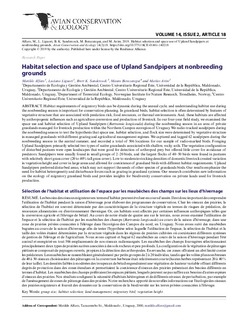| dc.description.abstract | Habitat requirements of migratory birds can be dynamic during the annual cycle, and understanding habitat use during the nonbreeding season is important for conservation planning. In grassland birds, habitat selection is often determined by features of vegetative structure that are associated with predation risk, food resources, or thermal environments. And, these habitats are affected by anthropogenic influences such as agriculture conversion and production of livestock. In our four-year field study, we examined the space use and habitat selection of Upland Sandpipers (Bartramia longicauda) during the nonbreeding season in an area of private grasslands managed for livestock production within the Northern Campos ecoregion of Uruguay. We radio-tracked sandpipers during the nonbreeding season to test the hypothesis that space use, habitat selection, and flock size were determined by vegetative structure
in managed grasslands with different grazing and agricultural management regimes. We captured and tagged 62 sandpipers during the nonbreeding season in the austral summer, and recorded a total of 506 locations for our sample of radio-marked birds. Foraging Upland Sandpipers primarily selected two types of native grasslands associated with shallow, rocky soils. The vegetation configuration of disturbed pastures were open landscapes that were good for detection of arthropod prey but offered little cover for avoidance of predators. Sandpipers were usually found in small groups of 2–20 birds, and the largest flocks of 40–50 birds were found in pastures with relatively short grass cover (20 to 40% tall grass cover). Low to moderate stocking densities of domestic livestock created variation in vegetation height and cover in large areas and allowed for coexistence of grassland birds with different habitat requirements. Upland
Sandpipers preferred disturbed areas, which may not support the needs of other species of grasslands birds. Our results emphasize the need for habitat heterogeneity and disturbance forces such as grazing in grassland systems. Our research contributes new information on the ecology of migratory grassland birds and provides insights for biodiversity conservation on private lands used for livestock
production. | nb_NO |
